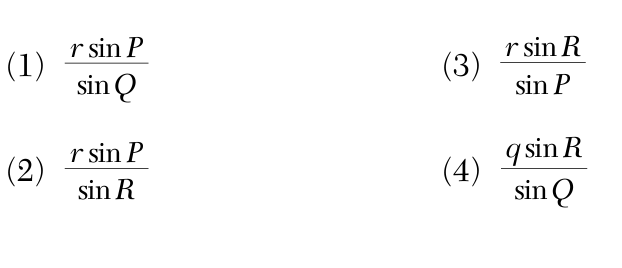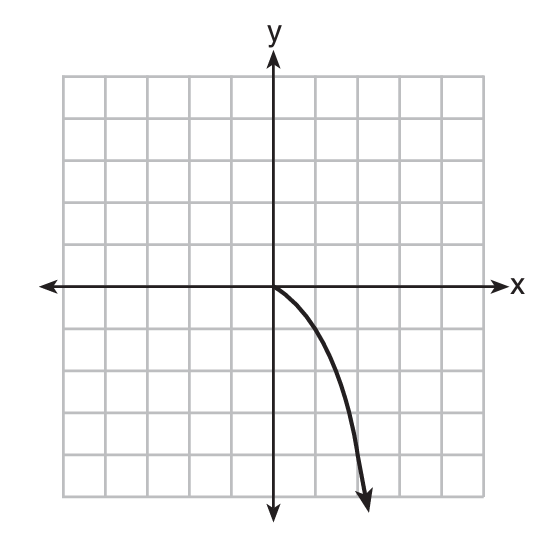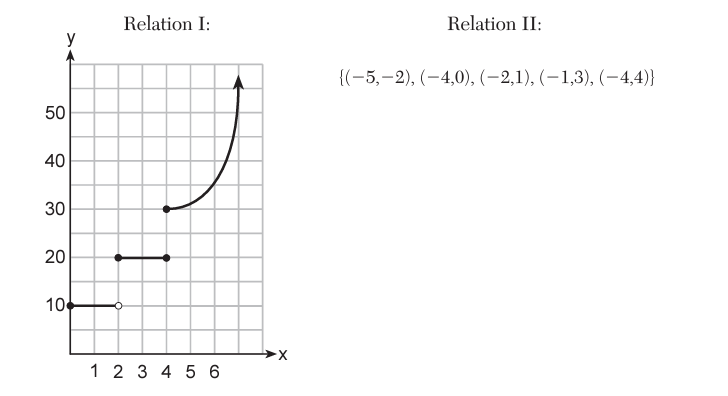In triangle PQR, p equals
(2)
(r sinP)/sinR
What is the formula for the nth term of the sequence B shown below?
B=10, 12, 14, 16, ...
b_n=8+2n
An infinite geometric series has a first term of -4 and a common ratio of 1/3. Evaluate the series.
-6
What is the range of the function shown below in interval notation? 
(-infty,0]
If f(x) = x2-5 and g(x)=6x, then g(f(x)) is equal to?
6x^2-30
120
What is the common ratio of the sequence
1/64a^5b^3, -3/32a^3b^4, 9/16ab^5, ...?
(-6b)/a^2
When will an infinite geometric series have a sum?
If the common ratio is 0<r<1
Which graph represents a one-to-one function? 
(3)
The minimum point on the graph of the equation y = f(x) is (-1, -3). What is the minimum point on the graph of the equation y = f(x) + 5?
(-1, 2)
A ranch in the Australian Outback is shaped like triangle ACE, with the following given information. Find the area of the ranch to the nearest square mile.
mangleA=42, mangleE=103, and AC=15 miles
44
What is the fifteenth term in the sequence 5, -10, 20, -40, 80, ...?
81,920
The sum of the first eight terms of the series 3 - 12 + 48 - 192 + ... is
-39,321
A is subtracted from B. What is the result?
A=3/2x^2-1/4x-4
B=5/2x^2-3/4x+1
x^2-1/2x+5
If g(x)=0.5x+8 and h(x)=0.5x-2, what is the value of g(h(-8))?
5
78.3 and 101.7
Write a recursive formula for the sequence 189, 63, 21, 7, ...
a_1=189
a_n=a_(n-1)(1/3)
The expression below is equal to
4+sum_(k=2)^5 3(k-x)
46-12x
Given the function below, what is its horizontal and/or slant asymptote?
f(x)=frac(4x^3-5x^2+8x-5)(2x^2 -4x+3)
Slant:
y=2x+3/2
For the function below, what are the domain and range?
y=3/sqrt(x-4)
Domain: x>4
Range: y>0
Two sides of a parallelogram measure 27cm and 32cm. The included angle measures 48 degrees. Find the length of the longer diagonal of the parallelogram to the nearest centimeter.
54
What is the difference between an arithmetic and a geometric sequence?
An arithmetic sequence adds or subtracts the same number for each successive term, while a geometric sequence multiplies the same number for each successive term.
Determine the number of terms n in the arithmetic series with
a_1=-5, d=2, and S_n=91
n=13
Identify the hole(s) and/or vertical asymptote(s) of the function below.
f(x)=(3x^2-5x-28)/(2x^2-3x-20)
Hole: (4, 19/13)
VA: x=-5/2
The two relations shown below are not functions. Explain how you could change each one so they they each become a function.

Answers will vary.